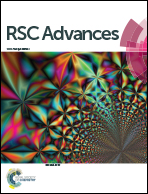A fluorescence turn-on probe for selective detection of nitrogen dioxide†
Abstract
Two copper(II) complexes, 1 and 2, of two ligands, L1 and L2 [L1 = 2-{[anthracen-9-ylmethyl-(2-dimethylamino-ethyl)-amino]-methyl}-4,6-di-tert-butyl-phenol; L2 = 5-dimethylamino-naphthalene-1-sulfonic acid (3,5-di-tert-butyl-2-hydroxy-benzyl)-(2-dimethylamino-ethyl)-amide, were synthesized and characterized. In methanol solution, the quenched fluorescence intensity of the ligands in complexes 1 and 2 was found to be restored upon exposure to nitrogen dioxide. This is attributed to the reduction of the paramagnetic Cu(II) centre by nitrogen dioxide to diamagnetic Cu(I). The reduction was accompanied by simultaneous nitration in the phenol ring of the ligands.


 Please wait while we load your content...
Please wait while we load your content...